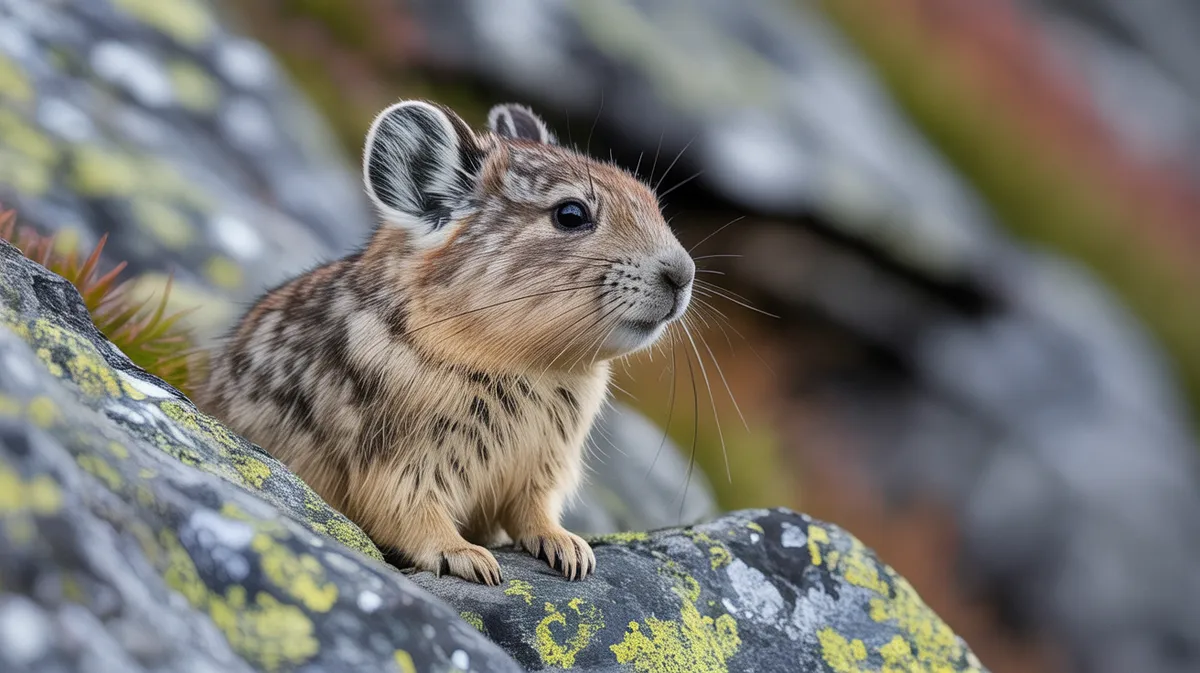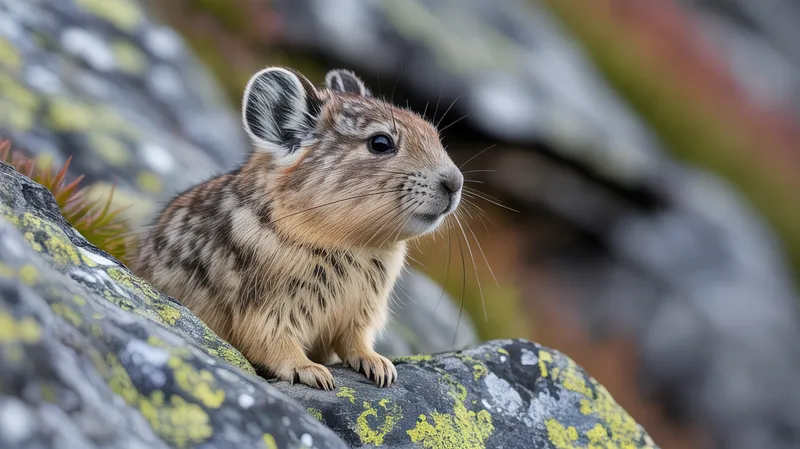
Northern Pika
Ochotona hyperborea

Meet the Northern Pika
The northern pika is a small, herbivorous mammal notable for its rounded body, short limbs, and lack of a visible tail. These animals are well-adapted to cold, mountainous environments and are distinguished by their thick fur and high-pitched calls. Pikas are known for gathering and storing vegetation in 'haypiles' to survive harsh winters. Their alert and lively behavior, as well as their distinctive vocalizations, make them an important component of alpine and subalpine ecosystems.
Classification
Mammal
Habitat
Mountainous rocky slopes and talus fields
Diet
Herbivore
Lifespan
3-7 years
Conservation
Least Concern
Weight
100-200 grams
📖Fascinating Facts
Mountain Specialists
Northern pikas are highly adapted to cold, rocky mountain environments and rarely stray far from talus slopes.
Haypile Builders
They spend summer collecting grasses, leaves, and stems to create haypiles, which serve as their primary food source during winter.
Vocal Warnings
Pikas use loud, sharp calls to alert others of predators and to defend their territories.
📋Detailed Description
The northern pika (Ochotona hyperborea) is a small, robust lagomorph with a compact, rounded body measuring 12.5–18.5 cm in length and weighing between 75–140 grams. Its fur is dense and soft, undergoing two seasonal molts: a reddish-brown pelage in summer and a grayer, thicker coat in winter, providing insulation against harsh alpine climates. The head is broad with short, rounded ears (1.7–2.1 cm), and the eyes are large and dark, adapted for vigilance. Limbs are short, with five toes on each foot; the forefeet are slightly broader, aiding in digging and handling vegetation. The tail is vestigial and almost invisible externally (0.5–1.2 cm). Northern pikas are diurnal, with peak activity during early morning and late afternoon. They are highly vocal, emitting sharp, high-pitched calls to communicate territory and alert others of predators. Unlike some pika species, O. hyperborea is primarily solitary, maintaining well-defined territories marked by scent glands. Their ecological role is significant as ecosystem engineers, influencing plant community composition through selective foraging and haypile construction. They are adapted to cold, rocky habitats, often found at elevations from 400 to over 2,500 meters, where they utilize crevices for shelter and nesting.
💡 Did you know?
The northern pika is extremely sensitive to heat and can die from overheating at temperatures as low as 25°C (77°F).
🔬Research & Sources
Wikipedia Summary
The northern pika is a species of pika found across mountainous regions of northern Asia, from the Ural Mountains to northern Japan and south through Mongolia, Manchuria and northern Korea. An adult northern pika has a body length of 12.5–18.5 centimeters (4.9–7.3 in), and a tail of 0.5–1.2 centimeters (0.20–0.47 in). The pika sheds its fur twice annually, bearing a reddish-brown coat in the summer and grayish-brown coat in winter. It feeds on various plant material and makes "hay piles" for winter use.
Last Modified: 3/2/2024
🎭Behavior & Social Structure
Northern pikas are primarily solitary and territorial, with each individual defending a home range of 400–1,200 square meters. They are most active during crepuscular hours, spending daylight foraging and collecting plant material. Feeding involves selective harvesting of grasses, sedges, forbs, mosses, and occasionally lichens, which are consumed fresh or dried in 'haypiles' for winter. Haypiling is a complex behavior involving the systematic gathering, drying, and storage of vegetation in sheltered rock crevices. Pikas use vocalizations—short alarm calls and longer territorial calls—to communicate, especially during the breeding season or when threatened by predators such as stoats, weasels, and birds of prey. Social interactions are limited outside of the breeding season, with aggressive chases and scent marking used to maintain territory boundaries. Daily routines include sun-basking, grooming, and vigilant scanning for threats.
👶Reproduction & Life Cycle
Breeding occurs from late April to August, with the timing influenced by altitude and local climate. Northern pikas are polygynandrous, with both males and females mating with multiple partners. Females produce 2–3 litters per year, each consisting of 2–8 altricial young. Gestation lasts approximately 21–24 days. Nests are constructed in rock crevices lined with dry grasses and moss. Neonates are born blind and hairless, gaining fur within a week and opening their eyes at around 9 days. Weaning occurs at 18–20 days, after which juveniles disperse to establish their own territories. Parental care is provided exclusively by the female, who defends the nest and young from conspecifics and predators.
🛡️Adaptations & Survival
Northern pikas possess several adaptations for survival in cold, mountainous environments. Their thick, seasonally variable fur provides insulation against subzero temperatures. The compact body shape minimizes heat loss, while short limbs and ears reduce surface area exposed to the cold. Physiologically, they have a high metabolic rate to maintain body temperature and can enter torpor during extreme conditions. Behaviorally, haypiling ensures a reliable winter food supply, as they do not hibernate. Their acute hearing and vision facilitate early predator detection, and their cryptic coloration provides camouflage among rocks. The ability to utilize a wide range of plant species allows them to persist in diverse alpine and subalpine habitats.
🎨Cultural Significance
Northern pikas have limited direct significance in human culture but are occasionally referenced in regional folklore as symbols of alertness and industriousness, owing to their haypiling behavior. In some indigenous Siberian and Mongolian traditions, pikas are considered indicators of environmental health and are sometimes featured in children’s stories. They are not commonly hunted or used for traditional medicine, but their presence is valued by local communities as part of the natural alpine landscape.
🔬Recent Research & Discoveries
Recent research has focused on the northern pika’s response to climate change, particularly shifts in altitudinal range and changes in haypile composition. Genetic studies have revealed significant phylogeographic structure, suggesting historical isolation in glacial refugia. Ongoing studies are examining the role of pikas in nutrient cycling and plant community dynamics, as well as their potential as bioindicators for monitoring ecosystem health. Notably, Ochotona hyperborea is being used as a model species for understanding the impacts of rapid environmental change on cold-adapted mammals.
🎥Wildlife Videos

Cute Pika Steals Food From Neighbours | 4K UHD | Mammals | BBC Earth
Some adorable pikas wait all winter for the sun to shine, so they can gather food and build their nests. But other cheeky pikas wait ...
BBC Earth

Pika: The Tiny Mountain Bandit | BBC Earth
Life in the mountains isn't easy. With just 10 snow-free weeks a year, the pika must work nonstop to stockpile food for the long, ...
BBC Earth

The Pika is Quick and Elusive | America the Beautiful
About National Geographic Wild: National Geographic Wild is a place for all things animals and for animal-lovers alike. Take a ...
Nat Geo Animals

The Wildlife of Costa Rica | Free Documentary Nature
The Wildlife of Costa Rica | Wildlife Documentary Watch 'Animal Armory - Survival in the Wild' here: ...
Free Documentary - Nature

The Fascinating Wildlife in Deep Mountain Lakes | Full Documentary
Germany's inland waterways, rivers, streams and lakes are a colourful and, in some cases, virtually untouched natural refuge.
Free High-Quality Documentaries

THE SWISS ALPS | Secrets of the Apex Hunters | Animal documentary
Welcome to the majestic Swiss Alps, a breathtaking wilderness that's home to some of the most extraordinary apex predators on ...
WILD NATURE - Nature animal documentary
🌍Habitat Information
The Northern Pika typically inhabits Mountainous rocky slopes and talus fields environments. Northern Pikas have adapted to their environments with specialized features and behaviors.
Primary Habitat:
Mountainous rocky slopes and talus fields
More detailed habitat information will be available soon.
🛡️Conservation Status
The Northern Pika is currently classified as Least Concern. Conservation efforts are crucial for preserving this species for future generations.
Common Threats:
- 🏠Habitat loss and fragmentation
- 🌡️Climate change impacts
- 🎯Hunting and poaching
- 🏭Human-wildlife conflict
⚠️Threats & Conservation Challenges
Currently classified as Least Concern by the IUCN, the northern pika faces localized threats from habitat fragmentation, climate change, and human encroachment. Warming temperatures may reduce suitable alpine habitat and disrupt the availability of preferred forage species. Overgrazing by livestock and mining activities can degrade talus habitats. Although populations are stable across much of their range, isolated populations may be vulnerable to stochastic events and genetic bottlenecks. Ongoing monitoring is needed to assess the impacts of climate change and land use on long-term viability.
🔬Scientific Classification
Scientific Name
Ochotona hyperborea
Classification Hierarchy
🔍 About Taxonomic Classification
Taxonomic classification is a hierarchical system used by scientists to classify and organize living organisms based on shared characteristics and evolutionary relationships.
The system moves from broad categories (Kingdom) to increasingly specific ones, with each animal's scientific name typically consisting of its Genus and species.
📝Community Notes
Share your observations and insights about the Northern Pika with our community of wildlife enthusiasts.
Join Our Community
Sign in to share your observations and connect with fellow wildlife enthusiasts.
Sign In to ContributeNo community notes yet
Be the first to share your observations about the Northern Pika!
Explore Northern Pika
Select a tab above to learn more about this amazing animal.
📸Photo Gallery
No photos available for this animal yet.
🌟Discover More Wildlife
Continue your journey of discovery with more fascinating animals from our database
